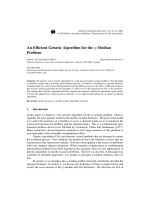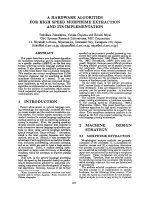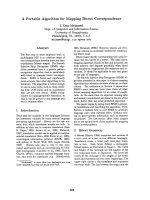A genetic algorithm for power aware virtual machine allocation in private cloud
Bạn đang xem bản rút gọn của tài liệu. Xem và tải ngay bản đầy đủ của tài liệu tại đây (214.72 KB, 9 trang )
A Genetic Algorithm for Power-Aware Virtual
Machine Allocation in Private Cloud
Nguyen Quang-Hung, Pham Dac Nien, Nguyen Hoai Nam,
Nguyen Huynh Tuong, and Nam Thoai
Faculty of Computer Science and Engineering
Ho Chi Minh City University of Technology
268 Ly Thuong Kiet Street, District 10, Ho Chi Minh City, Vietnam
{hungnq2,htnguyen,nam}@cse.hcmut.edu.vn,
{50801500,50801308}@stu.hcmut.edu.vn
Abstract. Energy efficiency has become an important measurement of
scheduling algorithm for private cloud. The challenge is trade-off between minimizing of energy consumption and satisfying Quality of Service (QoS) (e.g. performance or resource availability on time for reservation request). We consider resource needs in context of a private cloud
system to provide resources for applications in teaching and researching. In which users request computing resources for laboratory classes at
start times and non-interrupted duration in some hours in prior. Many
previous works are based on migrating techniques to move online virtual
machines (VMs) from low utilization hosts and turn these hosts off to reduce energy consumption. However, the techniques for migration of VMs
could not use in our case. In this paper, a genetic algorithm for poweraware in scheduling of resource allocation (GAPA) has been proposed
to solve the static virtual machine allocation problem (SVMAP). Due
to limited resources (i.e. memory) for executing simulation, we created a
workload that contains a sample of one-day timetable of lab hours in our
university. We evaluate the GAPA and a baseline scheduling algorithm
(BFD), which sorts list of virtual machines in start time (i.e. earliest
start time first) and using best-fit decreasing (i.e. least increased power
consumption) algorithm, for solving the same SVMAP. As a result, the
GAPA algorithm obtains total energy consumption is lower than the
baseline algorithm on simulated experimentation.
1
Introduction
Cloud computing [7], which is popular with pay-as-you-go utility model, is economy driven. Saving operating costs in terms of energy consumption (Watts-Hour)
for a cloud system is highly motivated for any cloud providers. Energy-efficient
resource management in large-scale datacenter is still challenge [1][13][9][5]. The
challenge of energy-efficient scheduling algorithm is trade-off between minimizing of energy consumption and satisfying demand resource needs on time and
non-preemptive. Resource requirements depend on the applications and we are
K. Mustofa et al. (Eds.): ICT-EurAsia 2013, LNCS 7804, pp. 183–191, 2013.
c IFIP International Federation for Information Processing 2013
184
N. Quang-Hung et al.
interested in virtual computing lab, which is a cloud system to provide resources
for teaching and researching.
There are many studies on energy efficient in datacenters. Some studies proposed energy efficient algorithm that are based on processor speed scaling (assumption that CPU technology supports dynamic scaling frequency and voltage
(DVFS)) [1][13]. Some other studies proposed energy efficient by scheduling for
VMs in virtualized datacenter [9][5]. A. Beloglazov et al. [5] presents the Modified
Best-Fit Decreasing (MBFD) algorithm, which is best-fit decreasing heuristic, for
power-aware VM allocation and adaptive threshold-based migration algorithms
to dynamic consolidation of VM resource partitions. Goiri, . et al. [9] presents
score-based scheduling, which is hill-climbing algorithm, to place each VM onto
which physical machine has the maximum score. However, the challenge is still
remain. These previous works did not concern on satisfying demand resource
needs on time (i.e. VM starts at a specified start time) and non-preemptive,
in addition to both MBFD and score-based algorithms do not find an optimal
solution for VM allocation problem.
In this paper, we introduce our static virtual machine allocation problem
(SVMAP). To solve the SVMAP, we propose the GAPA, which is a genetic
algorithm to find an optimal solution for VM allocation. On simulated experimentation, the GAPA discovers a better VM allocation (means lower energy
consumption) than the baseline scheduling algorithm for solving same SVMAP.
2
2.1
Problem Formulation
Terminology, Notation
We describe notation that is used in this paper as following:
–
–
–
–
–
–
–
–
–
–
2.2
V Mi : the i-th virtual machine
Mj : the j-th physical machine
tsi : start time of the V Mi
pei : number of processing elements (e.g. cores) of the V Mi
P Ej : number of processing elements (e.g. cores) of the Mj
mipsi : total required MIPS (Millions Instruction Per Seconds) of the V Mi
M IP Sj : total capacity MIPS (Millions Instruction Per Seconds) of the Mj
di : duration time of the V Mi , units in seconds
Pj (t): power consumption (Watts) of a physical machine Mj
rj (t): set of indexes of virtual machines that is allocated on the Mj at time t
Power Consumption Model
In this section, we introduce factors to model the power consumption of single
physical machine. Power consumption (Watts) of a physical machine is sum
of total power of all components in the machine. In [8], they estimated power
consumption of a typical server (with 2x CPU, 4x memory, 1x hard disk drive,
A Genetic Algorithm for Power-Aware Virtual Machine Allocation
185
2x PCI slots, 1x mainboard, 1x fan) in peak power (Watts) spends on main
components such as CPU (38%), memory (17%), hard disk drive (6%), PCI
slots (23%), mainboard (12%), fan (5%). Some papers [8] [4] [6] [5] prove that
there exists a power model between power and resource utilization (e.g. CPU
utilization). We assume that power consumption of a physical machine (P (.)) is
linear relationship between power and resource utilization (e.g. CPU utilization)
as [8][4][6][5]. The total power consumption of a single physical server (P (.)) is:
P (Ucpu ) = Pidle + (Pmax − Pidle )Ucpu
P Ej
Ucpu (t) =
c=1 i∈rj (t)
mipsi,c
M IP Sj,c
In which:
– Ucpu (t): CPU utilization of the physical machine at time t, 0 ≤ Ucpu (t) ≤ 1
– Pidle : the power consumption (Watt) of the physical machine in idle, e.g. 0%
CPU utilization
– Pmax : the maximum power consumption (Watt) of the physical machine in
full load, e.g. 100% CPU utilization
– mipsi,c : requested MIPS of the c-th processing element (PE) of the V Mi
– M IP Sj,c : Total MIPS of the c-th processing element (PE) on the physical
machine Mj
The number of MIPS that a virtual machine requests can be changed by its
running application. Therefore, the utilization of the machine may also change
over time due to application. We link the utilization with the time t. We re-write
the total power consumption of a single physical server (P (.)) with Ucpu (t) as:
P (Ucpu (t)) = Pidle + (Pmax − Pidle )Ucpu (t)
and total energy consumption of the physical machine (E) in period time [t0 , t1 ]
is defined by:
t1
P (Ucpu (t))dt
E=
t0
2.3
Static Virtual Machine Allocation Problem (SVMAP)
Given a set of n virtual machines {V Mi (pei , mipsi , tsi , di )|i = 1, ..., n} to be
placed on a set of m physical parallel machines {Mj (P Ej , M IP Sj )|j = 1, ..., m}.
Each virtual machine V Mi requires pei processing elements and total of mipsi
MIPS, and the V Mi will be started at time (tsi ) and finished at time (tsi + di )
without neither preemption nor migration in its duration (di ). We do not limit
resource type on CPU. We can extend for other resource types such as memory,
disk space, network bandwidth, etc.
186
N. Quang-Hung et al.
Algorithm 1. GAPA Algorithm
Start: Create an initial population randomly for s chromosomes (with
s is population size)
Fitness: Calculate evaluation value of each chromosome respectively in
given population.
New population: Create a new population by carrying out follows the
steps:
Selection: Choose the two individual parents from current population
based on value of evaluation.
Crossover: By using crossover probability, we create new children via
modifying chromosome of parents.
Mutation: With mutation probability, we will mutate at some position
on chromosome.
Accepting: Currently, new children will be a part of the next generation.
Replace: Go to the next generation by assigning the current generation
to the next generation.
Test: If stop condition is satisfied then this algorithm is stopped and
returns individual has the highest evaluation value. Otherwise, go to
next step.
Loop: Go back the Fitness step.
We assume that every physical machine Mj can host any virtual machine, and
its power consumption model (Pj (t)) is proportional to resource utilization at a
time t, e.g. power consumption has a linear relationship with resource utilization
(e.g. CPU utilization) [8][2][5].
The objective scheduling is minimizing energy consumption in fulfillment of
maximum requirements of n VMs.
2.4
The GAPA Algorithm
The GAPA, which is a kind of Genetic Algorithm (GA), solves the SVMAP. The
GAPA performs steps as in the Algorithm 1.
In the GAPA, we use a tree structure to encode chromosome of an individual.
This structure has three levels:
Level 1: Consist of a root node that does not have significant meaning.
Level 2: Consist of a collection of nodes that represent set of physical machines.
Level 3: Consist of a collection of nodes that represent set of virtual machines.
With above representation, each instance of tree structure will show that an allocation of a collection of virtual machines onto a collection of physical machines.
The fitness function will calculate evaluation value of each chromosome as in the
Algorithm 2.
A Genetic Algorithm for Power-Aware Virtual Machine Allocation
187
Algorithm 2. Construct fitness function
powerOfDatacenter := 0
For each host ∈ collection of hosts do
utilizationMips := host.getUtilizationOfCpu()
powerOfHost := getPower (host, utilizationMips)
powerOfDatacenter := powerOf Datacenter + powerOfHost
End For
Evaluation value (chromosome) := 1.0 / powerOfDatacenter
3
3.1
Experimental Study
Scenarios
We consider on resource allocation for virtual machines (VMs) in private cloud
that belongs to a college or university. In a university, a private cloud is built to
provide computing resource for needs in teaching and researching. In the cloud,
we deploy installing software and operating system (e.g. Windows, Linux, etc.)
for practicing lab hours in virtual machine images (i.e. disk images) and the
virtual machine images are stored in some file servers. A user can start, stop and
access VM to run their tasks. We consider two needs as following:
i A student can start a VM to do his homework.
ii A lecturer can request a schedule to start a group of identical VMs for
his/her students on lab hours at specified start time and in prior. The lab
hours requires that the group of VMs will start on time and continue in
spanning some time slots (e.g. 90 minutes).
iii A researcher can start a group of identical VMs to run his/her parallel
application.
3.2
Workload and Simulated Cluster
We use workload from one-day of our university’s schedule for laboratory hours
on six classes in the Table 1. The workload is simulated by total of 211 VMs and
100 physical machines (hosts).
We consider there are two kind of servers in our simulated virtualized datacenter, which includes two power consumption models of two power model of
the IBM server x3250 (1 x [Xeon X3470 2933 MHz, 4 cores], 8GB) and another
power model of the Dell Inc. PowerEdge R620 (1 x [Intel Xeon E5-2660 2.2 GHz,
16 cores], 24 GB) server with 16 cores in the Table 2. The baseline scheduling
algorithm (BFD), which sorts list of virtual machines in start time (i.e. earliest start time first) and using best-fit decreasing (i.e. least increased power
consumption, for example MBFD [5]), will use four IBM servers to allocate for
16 VMs (each VM requests single processing element). Our GAPA can finds a
better VM allocation (lesser energy consumption) than the minimum increase
of power consumption (best-fit decrease) heuristic in our experiments. In this
example, our GAPA will choose one Dell server to allocate these 16 VMs. As a
result, our GAPA consumes less total energy than the BFD does.
188
N. Quang-Hung et al.
Table 1. Workload of a university’s one-day schedule
Day
6
6
6
6
6
6
6
3.3
Subject
506007
501129
501133
501133
501133
501133
501133
Class ID Group ID Students Lab. Time
CT10QUEE QT01
5
—456———CT11QUEE QT01
5
123————DUTHINH6 DT04
35
123————DUTHINH5 DT01
45
—456———DUTHINH5 DT02
45
—456———DUTHINH6 DT05
35
123————DUTHINH6 DT06
41
123————-
Duration
(sec.)
8100
8100
8100
8100
8100
8100
8100
Experiments
We show results from the experiments in the Table 3 and Figure 1. We use a
popular simulated software for a virtualized datacenter is the CloudSim [14][6]
to simulate our virtualized datacenter and the workload. The GAPA is a VM
allocation algorithm that is developed and integrated into the CloudSim version 3.0.
On simulated experimentation, we have total energy consumptions of both
the BFD and the GAPA algorithms are 16.858KWh and average of 13.007KWh
respectively. We conclude that the energy consumption of the BFD algorithm
is higher than the energy consumption of GAPA algorithm is approximately
130%. In case of the GAPA, these GAPA use the probability mutation is 0.01
and size of population is 10, number of generations is {500, 1000}, probability
of crossover is {0.25, 0.5, 0.75}.
Table 2. Two power models of (i) the IBM server x3250 (1 x [Xeon X3470 2933 MHz,
4 cores], 8GB) [16] and (ii) the Dell Inc. PowerEdge R620 (1 x [Intel Xeon E5-2660 2.2
GHz, 16 cores], 24 GB) [15]
Utilization 0.0 0.1 0.2 0.3 0.4 0.5 0.6 0.7 0.8 0.9
1
IBM x3250 41.6 46.7 52.3 57.9 65.4 73.0 80.7 89.5 99.6 105.0 113.0
Dell R620 56.1 79.3 89.6 102.0 121.0 132.0 149.0 171.0 195.0 225.0 263.0
4
Related Works
B. Sotomayor et al. [12] proposed a lease-based model and First-Come-FirstServe (FCFS) and backfilling algorithms to schedule best-effort, immediate and
advanced reservation jobs. The FCFS and backfilling algorithms consider only
performance metric (e.g. waiting time, slowdown). To maximize performance,
these scheduling algorithms tend to choose free load servers (i.e. highest-ranking
scores) when allocates a new lease. Therefore, a lease with single VM can be
allocated on big, multi-core physical machine. This way could be waste energy,
both of the FCFS and backfilling does not consider on the energy efficiency.
A Genetic Algorithm for Power-Aware Virtual Machine Allocation
189
Table 3. Total energy consumption (KWh) of running: (i) earliest start time first with
best-fit decreasing (BFD); (ii) GAPA algorithms. These GAPA use the probability
mutation of 0.01 and size of population of 10. N/A means not available.
Algorithms
BFD
GAPA P10
G500 C25
GAPA P10
G500 C50
GAPA P10
G500 C75
GAPA P10
G1000 C25
GAPA P10
G1000 C50
GAPA P10
G1000 C75
GA’s Prob. Energy
GA’s
VMs Hosts Generations of Crossover (KWh) BFD/GAPA
211 100
N/A
N/A
16.858
1
211
100
500
0.25
13.007
1.296
211
100
500
0.50
13.007
1.296
211
100
500
0.75
13.007
1.296
211
100
1000
0.25
13.007
1.296
211
100
1000
0.50
13.007
1.296
211
100
1000
0.75
13.007
1.296
S. Albers et al. [1] reviewed some energy efficient algorithms which are used to
minimize flow time by changing processor speed adapt to job size. G. Laszewski
et al. [13] proposed scheduling heuristics and to present application experience
for reducing power consumption of parallel tasks in a cluster with the Dynamic
Voltage Frequency Scaling (DVFS) technique. We did not use the DVFS technique to reduce energy consumption on datacenter.
Some studies [9][3][5] proposed algorithms to solve the virtual machine allocation in private cloud to minimize energy consumption. A. Beloglazov et al. [3][5]
presented a best-fit decreasing heuristic on VM allocation, named MBFD, and
VM migration policies under adaptive thresholds. The MBFD tends to allocate
a VM to such as active physical machine that would take the minimum increase
of power consumption (i.e. the MBFD prefers a physical machine with minimum
power increasing). However, the MBFD cannot find an optimal allocation for all
VMs. In our simulation, for example, the GAPA can find a better VM allocation
(lesser energy consumption) than the minimum increase of power consumption
(best-fit decrease) heuristic in our experiments. In this example, our GAPA will
choose one Dell server to allocate these 16 VMs. As a result, our GAPA consumes
less total energy than the best-fit heuristic does.
Another study on allocation of VMs [9] developed a score-based allocation
method to calculate scores matrix of allocations of m VMs to n physical machines. A score is sum of many factors such as power consumption, hardware
and software fulfillment, resource requirement. These studies are only suitable
for service allocation, in which each VM will execute a long running, persistent
application. We consider each user job has a limited duration time. In addition
to, our GAPA can find an optimal schedule for the static VM allocation problem
on single objective is minimum energy consumption.
In a recently work, J. Kolodziej et al. [10] presents evolutionary algorithms for
energy management. None of these solutions solves same our SVMAP problem.
190
N. Quang-Hung et al.
Total Energy Consumption (KWh)
18
16.858
16
Energy (kWh)
14
13.007
13.007
13.007
13.007
13.007
13.007
12
10
8
6
4
2
0
Fig. 1. The total energy consumption (KWh) for earliest start time first with best-fit
decrease (BFD), GAPA algorithms
5
Conclusions and Future Works
In a conclusion, a genetic algorithm can apply to the static virtual machine
allocation problem (SVMAP) and brings benefit in minimize total energy consumption of computing servers. On simulation with workload of one-day lab
hours in university, the energy consumption of the baseline scheduling algorithm
(BFD) algorithm is higher than the energy consumption of GAPA algorithm is
approximately 130%. Disadvantage of the GAPA algorithm is longer computational time than the baseline scheduling algorithm.
In the future work, we concern methodology to reduce computational time of
the GAPA. We also concern some other constraints, e.g. deadline of jobs. We
also study on migration policies and history-based allocation algorithms.
References
1. Albers, S., Fujiwara, H.: Energy-efficient algorithms. ACM Review 53(5), 86–96
(2010), doi:10.1145/1735223.1735245
2. Barroso, L.A., H¨
olzle, U.: The Case for Energy-Proportional Computing, vol. 40,
pp. 33–37. ACM (2007), doi:10.1109/MC.2007.443
3. Beloglazov, A., Buyya, R.: Energy Efficient Resource Management in Virtualized Cloud Data Centers. In: Proceedings of the 10th IEEE/ACM International Conference on Cluster, Cloud and Grid Computing, pp. 826–831 (2010),
doi:10.1109/CCGRID.2010.46
4. Beloglazov, A., Buyya, R.: Adaptive Threshold-Based Approach for EnergyEfficient Consolidation of VMs in Cloud Data Centers. ACM (2010)
5. Beloglazova, A., Abawajy, J., Buyya, R.: Energy-aware resource allocation heuristics for efficient management of data centers for Cloud computing. FGCS 28(5),
755–768 (2012), doi:10.1016/j.future.2011.04.017
A Genetic Algorithm for Power-Aware Virtual Machine Allocation
191
6. Beloglazov, A., Buyya, R.: Optimal Online Deterministic Algorithms and Adaptive Heuristics for Energy and Performance Efficient Dynamic Consolidation of
Virtual Machines in Cloud Data Centers. In: Concurrency and Computation: Practice and Experience, Concurrency Computat.: Pract. Exper., pp. 1–24 (2011), doi:
10.1002/cpe
7. Buyya, R., Yeo, C.S., Venugopal, S., Broberg, J., Brandic, I.: Cloud computing
and emerging IT platforms: Vision, hype, and reality for delivering computing as
the 5th utility. FGCS 25(6), 599–616 (2009), doi:10.1016/j.future.2008.12.001
8. Fan, X., Weber, W.-D., Barroso, L.A.: Power provisioning for a warehouse-sized
computer. In: Proceedings of the 34th Annual International Symposium on Computer Architecture, pp. 13–23. ACM (2007), doi:10.1145/1273440.1250665
9. Goiri, J.F., Nou, R., Berral, J., Guitart, J., Torres, J.: Energy-aware Scheduling in
Virtualized Datacenters. In: IEEE International Conference on Cluster Computing,
CLUSTER 2010, pp. 58–67 (2010)
10. Kolodziej, J., Khan, S.U., Zomaya, A.Y.: A Taxonomy of Evolutionary Inspired
Solutions for Energy Management in Green Computing: Problems and Resolution
Methods. In: Kolodziej, J., Khan, S.U., Burczynski, T., et al. (eds.) Advances in
Intelligent Modelling and Simulation. SCI, vol. 422, pp. 215–233. Springer, Heidelberg (2012)
11. Sotomayor, B., Keahey, K., Foster, I.: Combining batch execution and leasing using
virtual machines. In: Proceedings of the 17th International Symposium on High
Performance Distributed Computing - HPDC 2008, pp. 87–96. ACM (2008), doi:
10.1145/1383422.1383434
12. Sotomayor, B.: Provisioning Computational Resources Using Virtual Machines and
Leases, PhD Thesis submited to The University of Chicago, US (2010)
13. Laszewski, G.V., Wang, L., Younge, A.J., He, X.: Power-aware scheduling of virtual machines in DVFS-enabled clusters. In: 2009 IEEE International Conference on Cluster Computing and Workshops, pp. 368–377 (2009),
doi:10.1109/CLUSTR.2009.5289182
14. Calheiros, R.N., Ranjan, R., Beloglazov, A., De Rose, C.A.F., Buyya, R.:
CloudSim: a toolkit for modeling and simulation of cloud computing environments
and evaluation of resource provisioning algorithms. Software: Practice and Experience 41(1), 23–50 (2011)
15. SPECpower ssj2008 results for Dell Inc. PowerEdge R620 (Intel Xeon E5-2660, 2.2
GHz)
ssj2008/results/
res2012q2/power ssj2008-20120417-00451.html
(last accessed November 29, 2012)
16. SPECpower ssj2008 results for IBM x3250 (1 x [Xeon X3470 2933 MHz, 4 cores],
8GB).
ssj2008/results/
res2009q4/power ssj2008-20091104-00213.html
(last accessed November 29, 2012)









